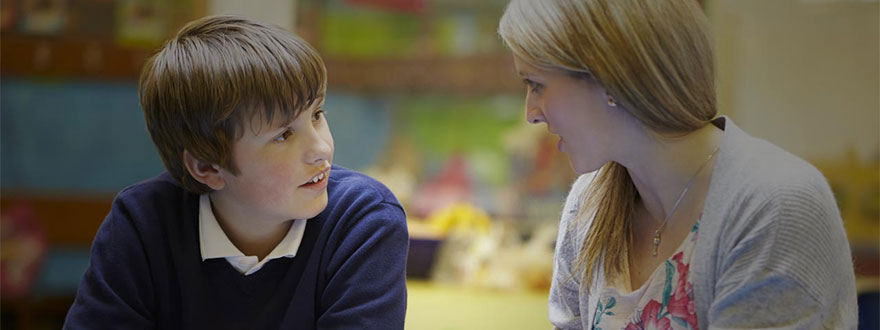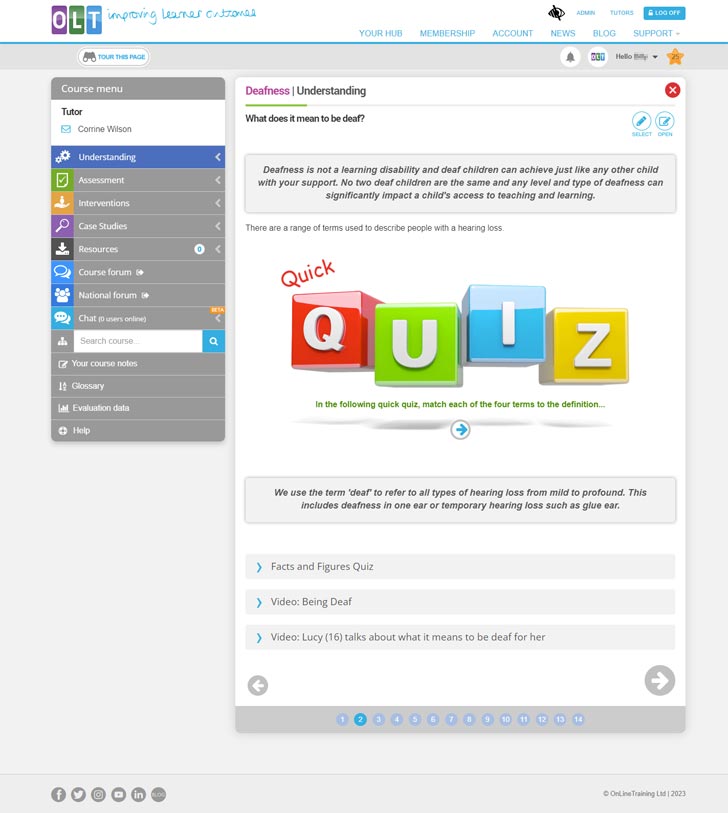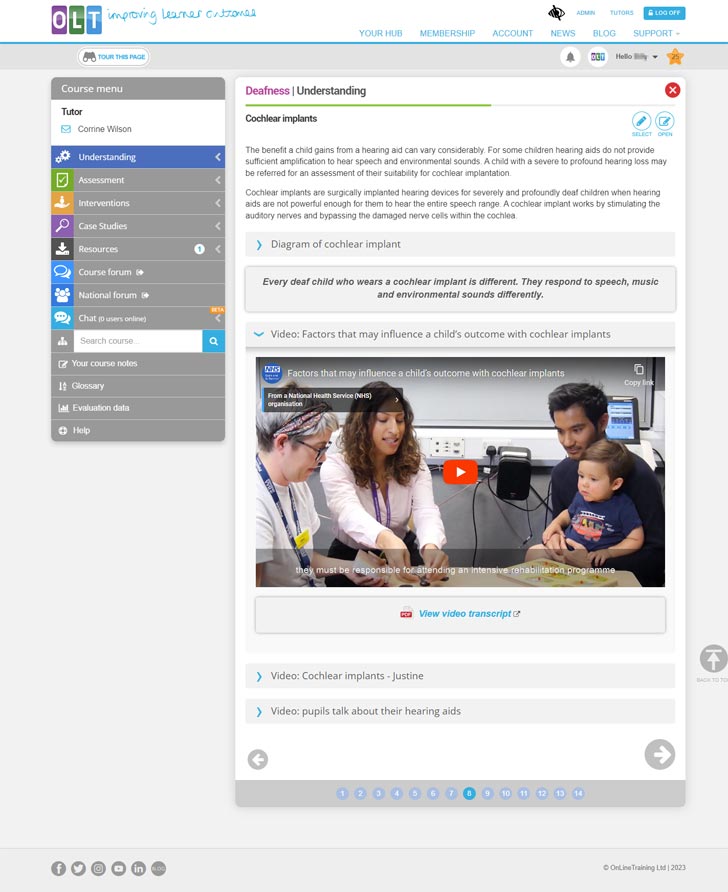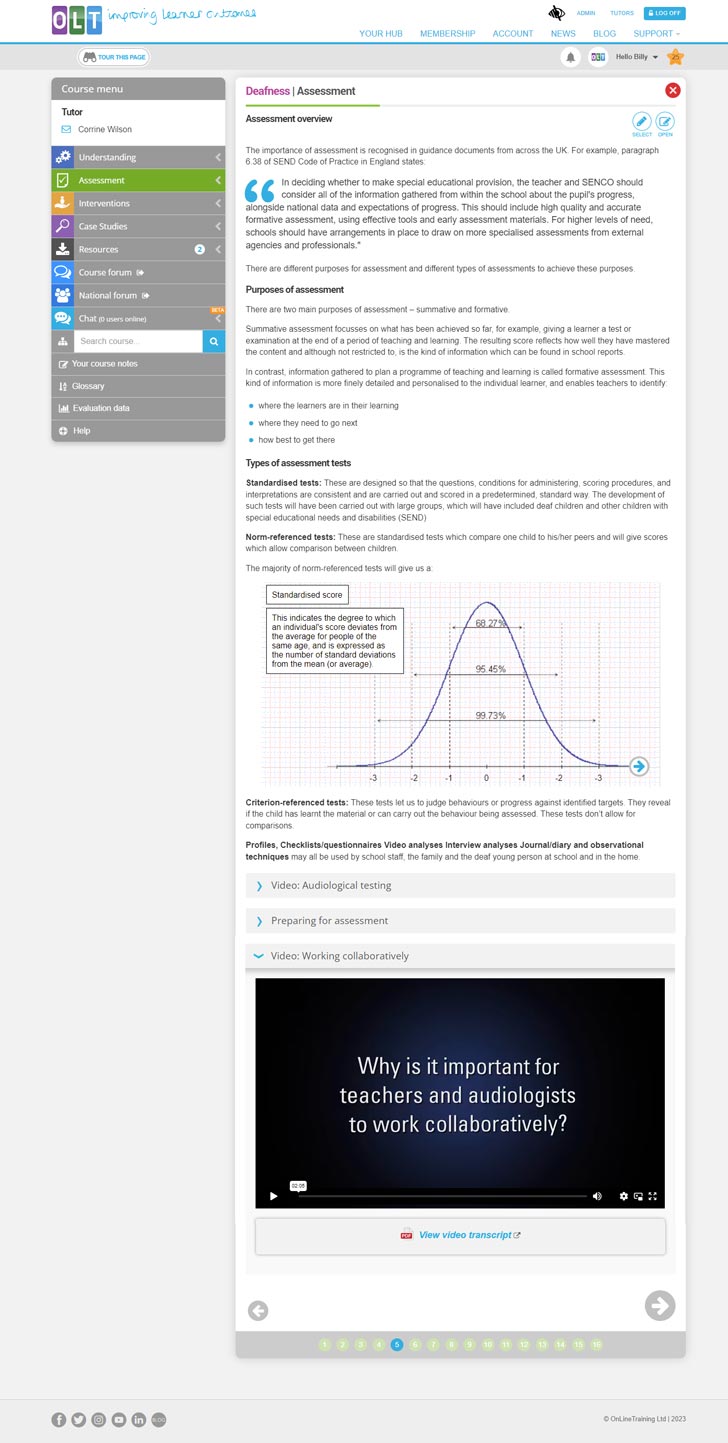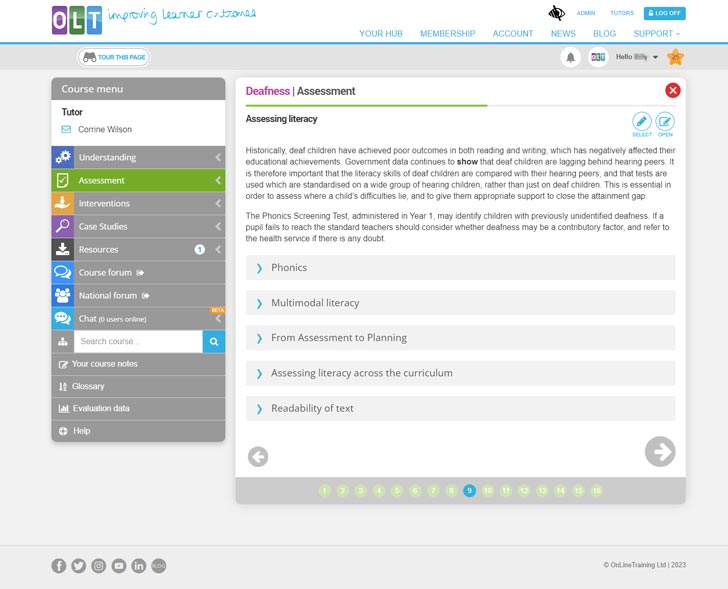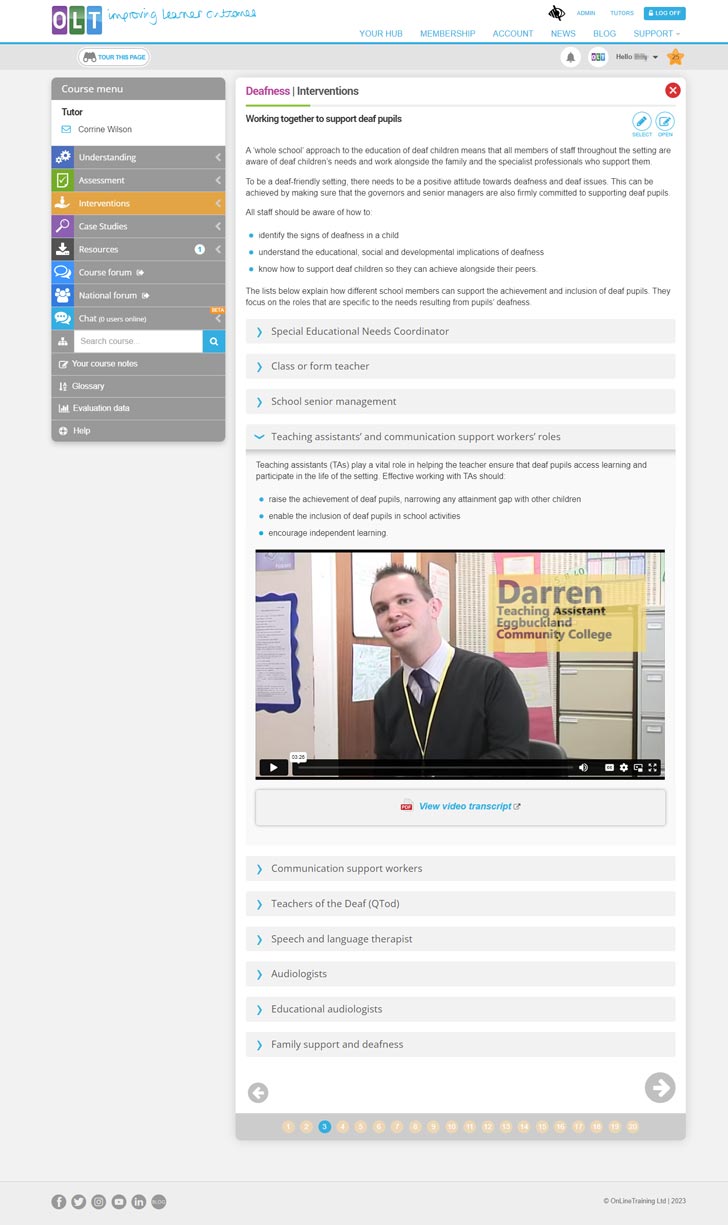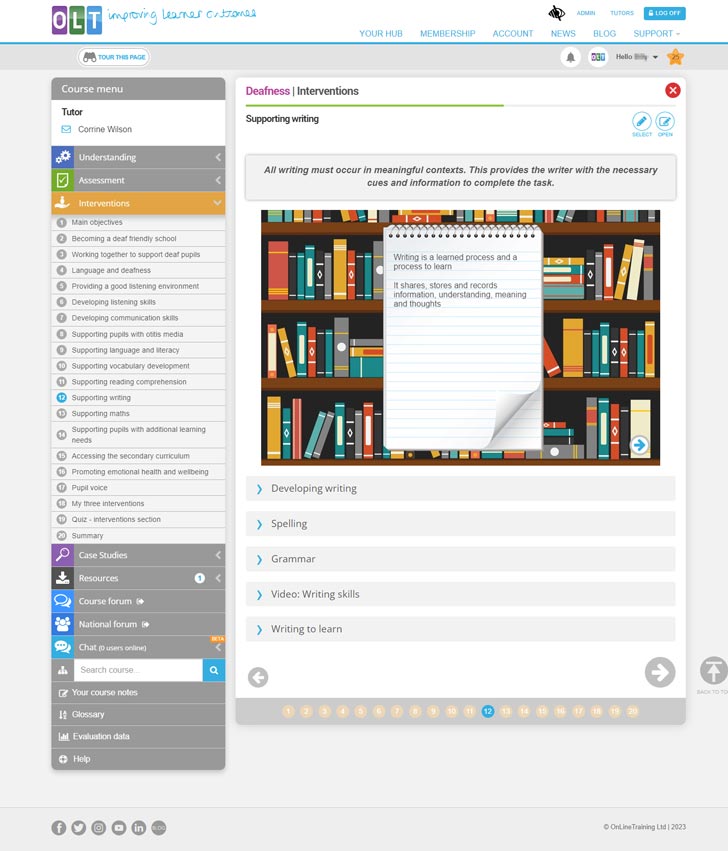“Talking in person to my tutor was most helpful, as it was easier to discuss different techniques.
“The training has given me a greater awareness of the social and emotional impact of deafness, and a greater appreciation of the educational challenges deaf students may face as a result of gaps in language, knowledge/abstract concepts. I also found the section explaining the different ways hearing losses are ascertained, and the biomechanics of the ear very interesting and it has given me greater confidence in the terminology I should use when describing a hearing loss or talking to a student with a hearing loss. Overall, I have found this course thoroughly interesting and would recommend it to any staff supporting deaf students.
“This training has increased my knowledge and understanding of deafness. In particular, I have learned a lot about the causes of hearing loss and the forms of communication and types of hearing aids that deaf students may use. I found the section on interventions really useful as it helped me to understand how best to support the student that I work with.
“This training has really made me think about my own setting and how we can use ideas that are shown to be beneficial for other children.
“It has made me more considerate of the teaching environment being offered to children who may have a hearing loss as well as their other additional learning needs that I am supporting.eg factors affecting the acoustics of the environment, especially at the present time with Covid restrictions in place and learning sessions mainly being offered virtually.
“I feel I have gained a much better understanding working with deaf children although I felt confident working with my pupil I feel now that I would be able to support other staff within school and give advice [to new teachers] when MG moves up the school.
“The training has had an impact on outcomes by helping me develop a better understanding on how to help and develop my pupil’s learning especially in communication. It has also given me different activities to try and help them focus more.
“This course has given me more knowledge and understanding of working with pupils with deaf pupils.
“It has made me realise how important it is to ensure that the pupils use their listening devices and sit in the correct position in class to help with their full understanding of the lesson content and lip read. I now understand that not only do the students have to deal with their deafness but also a lot of other issues too such as confidence and mental health issues.
“This course has given me a greater understanding and awareness of deafness and how better to support the children that I work with.
“This training has helped me to see where deaf pupils may struggle. It has made me much more aware of how I can adapt the environment to better suit the needs of the pupil and has also given me a variety of ideas/tools with which can help pupils with these needs.
“I am more confident to try other ways of helping deaf children.
“I have gained basic knowledge to help support a little deaf boy on my caseload - although he is younger than school entry age - the information I have learnt gives a good insight to what he is to expect when he starts school. I feel I am better equipped to support at Early Foundation stage and have the information, formed connections with the advisory teacher in the area, that has given further direction to improve my work practice.
“This training has certainly given me a more in depth understanding of deafness and how this can impact on an individuals learning and communication as well as the support out there for children when starting in educational settings. I am certainly more mindful of my positioning when working with deaf children, such as not sitting in front of a window, which has resulted in the child remaining more focused on me.
“This training has supported my understanding of deafness and the resources required for them.
“It's given me a more in-depth knowledge of deafness and lots of ways to support a deaf student in school. The tips and strategies to use have been invaluable.
“This training has been so helpful and I would recommend it to anyone and everyone. It has helped me gain a better understanding of deafness and hearing aids etc and it has made me want to learn even more. Thank you!
“The case studies were particularly useful as they gave a good insight into the learning the deaf children were making, using the relevant strategies. It was interesting to see their viewpoints too. I have taken away some of these strategies and have implemented them in my class where I can.
“The course has given me the confidence to apply for new jobs and discuss the knowledge I have gained during the interview process.
“It has made me more confident [about] how to support deaf children.
“This training has helped me gain awareness of deafness, it has helped shaped my strategies and approaches.
“I'm now much more aware of the difficulties and barriers to learning that deaf pupils face on a daily basis. Being more able to identify when pupil A is struggling or not engaged in learning means I can give support or an intervention when it's needed. Pupil A is beginning to show more confidence with learning and speaking which has produced success that she very clearly enjoys!
“This course has helped me understand a lot more about deafness and what to expect and how to achieve things.
“I really enjoyed the course and it has given me a better understanding of working with a deaf child in an education setting and has given me the tools to be able to enhance the pupils experience and has enabled me to be able to provide the best resources to give the pupil access to the same as her peers.
“Even though I have a deaf son, I was confident with hearing aids etc however it has helped me become more aware of the importance of how I can make the classroom a deaf friendly environment.
“Why I have finished so quickly is because I really enjoyed it. Learning lots of new things. It was just so good to be given ideas on how to support the children within our setting. I can't wait to use some of the ideas and put them into practice. I have spoken to my work colleges about things that I have learnt as we have a deaf child in every room. The information has helped them understand what helps the children as well. Unfortunately, I can’t work in every room in the nursery, but I have been feeding them the information as I have been learning it.
“The main thing I have taken from this course, among many others, is how to be very focused and specific in the setting of targets and interventions. I have realised I had a tendency to be quite broad in my outcomes - simply saying a child will learn a new sound - and didn't break the targets down in the necessary components. My tutor has been invaluable in helping me with this and it will definitely have a positive impact on both my teaching and my target setting for my TA.
“I now can understand more about how deaf children are affected especially within a classroom. I now feel that I can use my skills from this course to benefit them, for example I know where they should be sat and I know the interventions that I can put in place to help them.
“Before this course I had little to no understanding of deafness and the impacts it has on children and adults. However, after completing the course, I now feel very confident when it comes to identifying the needs of a deaf child and can implement appropriate strategies in order to support them in different areas of needs and in different environments. The different case studies have given me a good understanding of the feelings and views of deaf individuals and have expressed the importance of including those within planning and reflective activities.
“Through this training I have gained a far greater understanding of the deaf child in a mainstream school, the importance of inclusion throughout the whole school as well as changes necessary for the deaf child within the classroom environment. I am looking forward to putting my studies to good use within school very soon.
“This training has been very detailed and thorough in that it has given clear explanations on deafness. The information has been simple to understand. The course has given me a wider understanding of the different types of hearing aids and radio aids. I feel that with the knowledge I now have on deafness will help me in supporting deaf children and also be more aware of the types of hearing aids that children may use. Also, making simple but very important changes to day-to-day support and group teaching, such as, talking clearly and not too fast and not standing in front of the sunlight which will create a shadow and make lip reading very difficult.
“I am familiar with the course materials and the level of understanding required to complete the course.
“This course has been great for giving ideas and resources for interventions. It has given me a clear understanding of the equipment used and how I will be able to use FM equipment in school. I've enjoyed passing on my knowledge to colleagues and putting it into practice.
“Really enjoyed this course and believe it has helped me to support deaf pupils. I have only been in this role for 6 months however this course has helped me gain better understanding and improved my practice within the classroom. A shame we couldn't meet face to face during COVID. Thank you for your support.
“I feel this course has given me an improved understanding of deafness and how best to support the children and families I work with.
“I am confident that I now possess the information and knowledge to have a positive impact on the learning of deaf children.
“This training has been very informative and interesting.
“This training would be good as an introduction to new staff with little understanding of deafness.
“It has given me more of an understanding of the obstacles that a deaf person can have and the responsibilities of caregivers to make sure they understand each person’s individual needs and not just put them in a box. To treat every deaf person as an individual. It’s also great to know the technology that we will hopefully be getting in the school to make his life easier.
“Really enjoyed this training and I enjoyed watching and listening to the videos and hearing the accounts from all angles.
“I really enjoyed hearing from deaf learners in the various videos. It helped me to understand what it was like to live in society with hearing loss. I am definitely more confident on how to support my current deaf learner and any future kiddies that I may meet. I have really enjoyed getting to know my learner this year - his attitude towards education and life has been an eye-opener to me. I've also enjoyed building a relationship with his mom and our external support teachers. I am happy to have completed this course - it was well worth it. Thank you.
“It helps you to focus on meeting each individual child's needs and requirements to access learning.
“This training has really helped me to be more observant and mindful of all the needs of the child I support and has given me more confidence to interact with teachers on his behalf.
“This course has been very useful to complete. I have limited experience teaching deaf pupils, but it highlighted the gaps in my knowledge and has given me a range of useful, practical tools to use in my teaching. I now feel a lot more confident in teaching my deaf pupil. I also now have a new understanding of how the learning environment will have a direct impact on the pupil. I have enjoyed learning about the reasons for hearing loss and it has explained aspects of the human auditory system that I knew little about. It has been very useful to set SMART targets and look at how I can improve my teaching practice which will result in a positive outcome for my pupil. I have also enjoyed reading my colleagues comments in the forums and can relate what they have said to my own teaching. I recommend this course to any member of teaching or support staff working with deaf pupils.
“Allowed me to better communicate with deaf students. I feel like my communication is now more effective.
“The first section of the course with information about hearing loss and levels, the different types of hearing aid equipment and ways of assessing was useful and interesting. The case studies were interesting to watch and to hear the opinions and thoughts of young deaf people, however, I found this section to be less relevant to my role. The children in the examples were all older and more capable, whereas many of the deaf children we see have more complex needs. However, I did find it particularly useful in this instance to hear the parents’ views and to be reminded of how overwhelming it can all be at this stage and the number of professionals involved within a child's life. It has made me think about the environment in home visits and currently video calls, and the importance of joint visiting with specialist teachers and working together.
“By doing the training it focusses you on the specifics needed. It allows you to think critically and tailor interventions and make 'smart' targets for the child.
“I think it has highlighted the need to take lots of small steps to ensure a pupil continues to make progress and evaluate our role/ interventions.
“I know I said questions 1-3 I was only somewhat confident with; although I’m confident with the theory, I feel like I need more practice in person before I will be fairly/strongly confident. I look forward to implementing this training in my practice, which, due to the school I work at, is very child led.
“I feel more confident in my ability to understand the needs of the students I work with and to provide the best possible outcome for their learnin.
“I feel that this training has expanded my knowledge of deafness within a school setting. Also, things like what to do when working in a mainstream class with a deaf student, things like how you position both yourself and the young person. Even so much as how to stand at the board. It has been very insightful and I'm sure I will use things I have learnt during my work.
“This training has helped me to gain a deeper understanding of how to support the children in my class better, once school returns to normal, I will put into practice what I have learned.
“Because deafness is invisible, it is difficult to understand just how much it can affect a child’s day-to-day life and lifelong potential. However, it is accepted that deaf children are at educational risk. Parents, teachers, audiologists and other professionals should work together with the child, to understand the hearing loss and to advocate for their listening needs. This training provides information and resources about how deafness can impact listening, learning as well as the possible social impact of deafness. Thank you.
“It has given more ways and new ideas on how to help deaf students. It has shown how to keep them as inclusive as possible which is good for their mental health and self-esteem. Which can be very much affected if not, it can make them feel very alone. I know a child who was like this when he was moved to another school away from his friends, luckily he has settled now.
“The training was very informative. Whilst lots of information was shared it was presented in a very user-friendly way - with lots of visuals, recaps and small quizzes. I particularly enjoyed watching the case studies and where the children detailed lots of ways in which staff both hinder and help them. The fact that training was online and with no time constraints meant that it has been easy for me to dip in and out. The fact that you can scroll back to previous sections was useful especially if there was a long break between training sessions. The course tutor introduced herself at the beginning and made sure we could communicate to her if any problems or questions arose. She also made sure to check in regularly by sending emails and responded quickly to myself and colleagues who at first struggled to answer some questions with regards to our role, she amended the questions and detailed more forum topics which made contributing easier. I look forward to undertaking similar training on a variety of topics.
“I enjoyed the course and added to my knowledge of deafness that I already had. What I have learnt I will try and pass onto classes that have deaf pupils. I will also let other staff know that I have done this course and if I can help them in any way I will.
“I enjoyed the course; I did have some understanding about deafness before I started the course. I will now use my new knowledge and pass this on to my colleagues, so we can all help our pupil to become more independent in her school and personal life.
“This training has taught me how to support deaf learners in numerous ways. For example, giving them more time to process the tasks and their responses to my questions. I feel confident when working with a deaf child, I will ensure they have the best opportunities to develop both educationally and socially.
